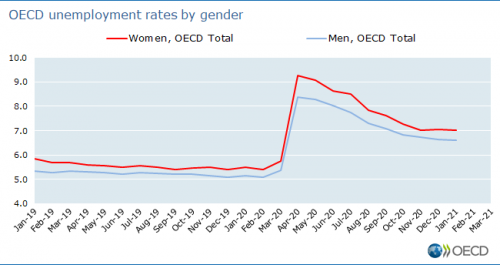Unemployment Rates, OECD - Updated: March 2021
OECD unemployment rate stable at 6.8% in January 2021, 1.6 percentage points higher than in February 2020
The OECD area unemployment rate was stable at 6.8% in January 2021, remaining 1.6 percentage points above the level observed in February 2020, before the COVID-19 pandemic hit the labour market.

In January 2021, the unemployment rate was stable in the euro area as well, at 8.1% for the third consecutive month, 0.8 percentage point above its February 2020 level. The largest declines in this area, of 0.2 percentage point or more, were recorded in Belgium, the Netherlands and Spain, while increases of 0.2 percentage point or more were observed in Latvia, Lithuania, Portugal and the Slovak Republic.
The unemployment rate fell by 0.4 percentage point in the United States (to 6.3%) in January, and more recent data show that it declined further, by 0.1 percentage point, in February 2021 (to 6.2%), along with a decrease in the number of people on temporary lay-off. In January, declines of 0.2 percentage point or more were also observed in Australia (to 6.4%), Colombia (to 14.3%) and Israel (to 4.5%), while a marginal decline was registered in Japan (to 2.9%). The unemployment rate increased by 0.2 percentage point in Mexico (to 4.5%), by 0.6 percentage point in Canada (to 9.4%) and by 0.9 percentage point in Korea (to 5.4%, its highest level since October 1999).
The OECD unemployment rate for women (at 7.0%) remained 0.4 percentage point above that for men (at 6.6%) in January 2021. This gap was about the same level as in February 2020, and well below the 0.9 percentage point observed in April 2020. The OECD youth unemployment rate (people aged 15 to 24) decreased slightly to 14.0% in January (from 14.2% in December).
More generally, it should be noted that unemployment statistics do not account for the full amount of labour market slack due to Covid-19, as some non-employed people may be classified as “out of the labour force”, because, due to the pandemic, they are either not able to actively look for a job or are not available to work.
Source: Organisation for Economic Co-operation and Development
- 402 reads
Human Rights
Fostering a More Humane World: The 28th Eurasian Economic Summi

Conscience, Hope, and Action: Keys to Global Peace and Sustainability

Ringing FOWPAL’s Peace Bell for the World:Nobel Peace Prize Laureates’ Visions and Actions

Protecting the World’s Cultural Diversity for a Sustainable Future

Puppet Show I International Friendship Day 2020

